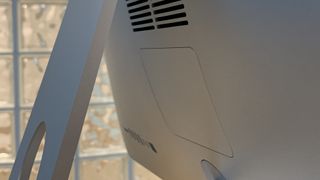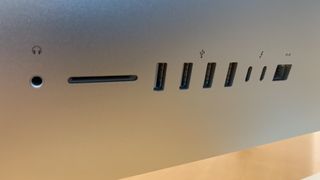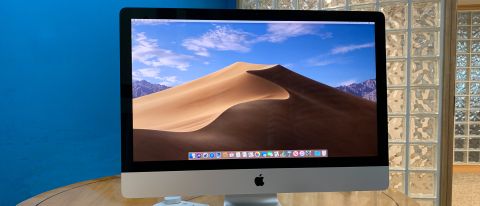Why you can trust TechRadar
Last year, we were impressed by the advances Apple brought to the Mac mini, which surpassed performance seen in at least some 2017 iMacs.
Now, the iMac has been updated with the eight-core Intel Core i9 option, which isn’t available on the Mac mini. A high-end iMac 2019 is an appealing proposition if you’re tackling tasks that make heavy use of CPU power.
The eight-core i9 achieves a single-core Geekbench score that’s 9% higher than we got from the Mac mini’s six-core i7. However, it’s the i9’s multi-core performance that truly shines, with a hugely impressive 35% higher Geekbench score.
Here’s how the Apple iMac (27-inch, 2019) performed in our suite of benchmark tests:
Cinebench R15 CPU: (single-core) 205.3 points, (multi-core) 1,736.4 points; Graphics: 167.7 fps
Cinebench R20 CPU: (single-core) 503.4 points, (multi-core) 4,257.2 points
Geekbench 4: 6,383 (single-core); 33,660 (multi-core)
Rise of the Tomb Raider (High preset, 1,920 x 1080): 77 fps
Rise of the Tomb Raider (High preset, 4,096 x 2,304): 34 fps
Rise of the Tomb Raider (High preset, 5,120 x 2,880): 23 fps
Blackmagic Disk Speed Test: (read) 2.5 GB/sec, (write) 1.9GB/sec
Last year, we started using HandBrake to test the capability of Mac CPUs by transcoding a 57-minute, 1080p video to the demanding HEVC format. We use the app’s “Apple 1080p30 Surround” preset, but switch the video encoder to ‘H.265 (x265)’.
The Core i9 aced this test as well, blazing through the conversion in a faster-than-real-time 43 minutes and 56 seconds. Compare that to the 2.7GHz quad-core i7 in last year’s 13-inch MacBook Pro (1 hour and 32 minutes) or the 2.7GHz quad-core i7 in 2016’s 15-inch MacBook Pro (1 hour and 33 minutes) and the benefit of shelling out a few extra hundred on the i9 is
clear.
Churning through huge amounts of data doesn’t always depend on CPU capability. Some software requires a powerful GPU instead.
To test the capability of the optional Vega 48 GPU, we encoded our 2.5-minute, effects-laden DaVinci Resolve project to a 720p, H.264-format video file. The iMac finished this test in 9 minutes and 19 seconds.
That’s actually more than a minute faster than when we connected our Thunderbolt 3 eGPU, which contains an AMD Radeon Vega 64 card. When connected to the same iMac, the eGPU took 10 minutes and 42 seconds to finish the task.
Even so, gaming at 5K or even 4K resolutions isn’t advisable even with a better GPU like the Vega 48. In the Rise of the Tomb Raider benchmark, with all effects turned up to maximum, the mean average frame rate at those resolutions was just 19 and 27 frames per second (fps), respectively. Switching to the game’s ‘High’ quality preset brought frame rates up to 23 and 33 fps, the latter (4K) approaching playable levels.
Really, with iMac 2019 gaming you’ll get much better performance by lowering resolution instead of effects quality. At 1,920 x 1,080, the mean average rose to a very comfortable 77 fps, though this particular game’s toughest scenes still see dips as low as the high teens.
Thanks for the (not much) memory
Even in 2019, all three 27-inch iMacs 2019 come with 8GB of RAM to start. That’s sufficient for light use, but 16GB would be wise for creative work, or just to avoid macOS paging things out to disk when you have a lot of apps and documents open.
The top-of-the-range Inspiron 27 7000 includes 16GB of DDR4 memory. Its clock speed even matches the iMac 2019’s, which Apple has upped to 2,666MHz in 2019 models.
Our review iMac 2019 came with 16GB, fitted as two 8GB modules, just like in the Inspiron 7000. That leaves you with two memory slots available to expand the iMac further. Unlike on the 21.5-inch iMac, here the memory is user-upgradeable via the back panel.

There are significant savings to be had by upgrading the memory yourself. Apple wants $200/£180/AU$320 to fit 16GB on your behalf, but it’s only around $118/£120/AU$260 to buy two 8GB modules. Self-installation makes even more sense if you need a larger amount of space, because Apple’s prices quickly shoot up: it’s $600/£540/AU$960 just for 32GB. You can get that amount for $228.99 (about £176/AU$321) from places like Mac specialist Other World Computing.
We strongly advise shopping around for memory. Just ensure you follow the usual precautions for handling electronics when installing it.
In doing so, you’re making the exact same compromise on capacity in favor of speed as when dispensing with the 1TB Fusion Drive. However, in this case, you get a more comfortable capacity that might delay how soon you’ll need to offload files to external storage.
A fistful of gigabytes
Even in 2019, the iMac hasn’t switched to using purely SSD storage as standard. You have to pay more to get that. Instead, Apple has stuck with its Fusion Drive tech as the default, which combines a small SSD and a large hard disk in a way that presents them to you as a single drive.
Behind the scenes, macOS works out what data you use most often – at the block level, not simply whole files – and keeps as much as possible on the SSD. It moves less important data to the hard disk without you having to think about where things are at.
Contrast that with the Inspiron 7000’s combination of a 256GB PCIe-based SSD and a 1TB hard disk. The former holds Windows 10 and your apps, the latter your personal files. For a little more than the 27-inch iMac’s starting price, HP’s Envy 27-b206na’s goes a bit better.
Like Dell’s PC, it has a 256GB SSD, but that’s backed by a 2TB hard disk, kicking the likelihood you’ll need an external archive further into the long grass. But, as we said earlier, look closely for other compromises. The Envy has the same amount of RAM as the iMac to start.
While the Fusion Drive is convenient, it increasingly looks like sticking plaster on Apple’s part. Back in 2012, Apple used a 128GB SSD in Fusion Drives. Since 2015, it has reduced that to just 24GB in 1TB models. It doesn’t take long before macOS has to shuffle data back and forth.
Not all PCIe-based NVMe SSDs are equivalent; some have slower transfer rates. And, Microsoft’s high-end rival, the Surface Studio 2, is well over three grand, doubtless not helped by offering a 1TB SSD as the minimum capacity.
But, this is one area where we’d be happy for Apple to make a slight compromise, so that no iMac buyer has to encounter the near-inevitable drawback that a Fusion Drive will, at some point, have to spin up its hard disk component.
It costs $100/£90/AU$160 to swap the 1TB Fusion Drive (included in the bottom and middle 27-inch iMacs) for a fast SSD. That gets you 256GB of storage, which isn’t too bad a deal, but it’s painful to step up to 512GB or 1TB. The former alone will take another $300/£270/AU$480 out of your bank account.
It’s only if you start with the top 27-inch iMac that upgrading to a 512GB SSD becomes palatable. That model has a 2TB Fusion Drive to start with, so replacing that with a half-tenable SSD costs the same here as a 256GB drive does on the less expensive 27-inch iMacs.

In doing that, you’re still making the exact same compromise on capacity in favor of speed as when dispensing with the 1TB Fusion Drive. But, in this case, you get a more comfortable capacity that might delay how soon you’ll need to offload files to external storage.
Watch those files fly
To test storage transfer rates, we used BlackMagic Disk Speed Test and QuickBench. The former alternates between writing and reading a 5GB file.
Thunderbolt 3-connected SSDs we’ve tested recently throttle their performance to deal with the build-up of heat under prolonged activity. We saw nothing like that impact on the iMac’s SSD.
The iMac’s SSD maintained read and write speeds of 2.5 and 1.9GB/sec, respectively, even after looping the test for 15 minutes. The iMac’s much larger, actively cooled body likely helps with that. Want to see how a Fusion Drive holds up? Check out our imminent 21.5in iMac review. (Spoiler: the hard disk part is a real performance bottleneck.)
QuickBench revealed that the SSD is actually capable of higher transfer rates – up to 3.18GB/sec when reading data – but it’s better to take the Blackmagic figures as an indication of sustained performance.
Final verdict
Among the components in our customized review unit, memory stands out as something that can wait until you know you need more. If you already know that you will, it’s clear why you should still avoid paying Apple’s memory prices.
Put any saving you make towards upgrading the iMac’s storage. That’s one thing all iMac buyers should immediately upgrade. Having a hard drive component in an iMac, even as part of a Fusion Drive, is the biggest weak spot. Make the internal drive the fastest available, in the biggest capacity your budget allows to avoid the performance issues we see in the Fusion Drive.
If you don’t need blisteringly fast graphics performance from day one, macOS’s relatively recent support for eGPUs means you could put off that decision until later. You can’t do the same for an iMac’s CPU. That said, the one eGPU we had available performed slightly worse in one app than Apple’s Vega 48 upgrade.
Likewise, if your workload is heavy – whether from multiple apps competing for the processor, or one app taking all the processing capacity made available to it – you should seriously consider the Core i9 upgrade. You’ll see from our imminent 21.5-inch iMac review that it pays off handsomely with demanding software.
Upgrading to a Core i9 and a 256GB SSD takes the price of the mid-range 27-inch iMac to $2,599/£2,489/AU$4,029. If you have to make a hard choice between them, or simply don’t need extreme CPU or GPU power, the one upgrade you should go for is an SSD to avoid frustration caused by the impact of Apple’s decision to pair tiny SSDs with slow hard disks.
Ultimately, the 2019 iMac is a fine upgrade to the 2017 model, especially for prosumers and creative professionals, and one of the best premium all-in-one PCs that money can buy. Just look out for those steep memory and storage prices, and consider an alternative mouse.
- 1
- 2
Current page: Performance, features and verdict
Prev Page Introduction, price, design and display
